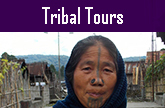Assam Tourism
Assam, the land of "blue hills and red river", earlier known as Pragjyotishpura, lies like a green fairy in the bosom of the exotic North East. The mighty river Brahmaputra and river Barak are garlanding the fairy with glittering necklace. Due to its magnificent scenic beauty surrounded by hills in every direction along with silvery rivulets, the name of this fairy state is derived as 'Assam' meaning in Sanskrit language as 'unequal'.
Assam : At A Glance
State Capital:
Dispur
State Language:
Assamese
State Festival:
Bihu
State Dance:
Bihu Dance
State Animal:
One-horned Rhinoceros
State Bird:
White-winged Wood Duck
State Flower:
Kopou Phul (Foxtail Orchids)
State Tree:
Hollong (Dipterocarpus Macrocarpus)
Sex Ratio:
958 females for each 1000 males (Census Report of India, 2011)
Population Density:
396.8 per square kilometer
Major Crops:
Rice, Maize, Wheat, Jute, Cotton, Sugar cane, Arecanut, Coconut
Major Plantations:
Tea, Rubber, Coffee
Major Minerals:
Coal, Limestone, Petroleum, Granite, Sillimanite, Iron ore, Quartzite, Feldspar, Clay
Geographical Location:
Longitude -- 89.420 E to 96.00 E & Latitude -- 24.50 N to 28.00 N
Area
At present, Assam encompasses an area of about 78,438 sq km with 27 districts falling under it. The two main rivers flowing through it is the mighty Brahmaputa and the Barak River.
Population
Assam has a population of about 31,169,272 out of which 15,954,927 are males and 15,214,345 are females. (Census Report of India, 2011)
Literacy
The literacy rate in Assam is 73.18%. Of that, the male literacy rate is 78.81 % while female literacy is 67.27 %. (Census Report of India, 2011)
Climate
Assam has a tropical climate of cool, arid winter and hot, rainy summer. Average temperature is 30' C in summer and 16' C in winter. Assam experiences an average annual rainfall of 230 cm.
Economy
The economy of Assam is predominantly based on agriculture. The industries in Assam are based on the resources like agriculture, forest and minerals available in the state. Oil & natural gas, tea, paper, cement and petro chemical products are some of the major industries present in Assam.
History of Assam
Pre-History Period
According to Kalika Purana (a work of 10th C AD) the earliest rulers of Assam were non-Aryans ie, the descendants of the Danava (demon) dynasty, the founder of which was King Mahiranga Danav. Amongst the Danava kings, Narakasura was the mightiest and learned ruler who established the capital of his empire at Pragjyotishpura ie, modern Guwahati. Bhagadutta, the eldest son, was enthroned later as the king of Pragjyotishpura after the death of King Narakasura. The heroic death of warrior Bhagadutta is elaborated in the epic Mahabharata with great praise and glory as the king took part in the battle of Kurukshetra in favour of Durjyudhana.
Ancient History
The later dynasties that established its rule over Kamarupa were - the Barman dynasty (350AD - 650AD), the Salastambha dynasty (650AD - 990AD) and the Pala dynasty (990Ad - 1138AD). Of all these dynasties, Bhaskar Varman was the most well known and the supreme king who ruled over ancient Assam. The visit of Huien Tsang, the Chinese pilgrim to Kamarupa in 643AD is a remarkable event in the reign of Bhaskar Varman. He recorded in his travelogues the commendable culture and civilization, social and political life of Assam during that period.
Assam experienced many foreign invasions after the fall of Pala dynasty. The Turkish led their several attempts to invade the kingdom in the 13th Century, but this "great kingdom of the East" fought bravely and compelled the Muslim invaders to retreat back to their country.
Medieval History
During the early part of 13th Century, the Ahom dynasty occupied the whole of eastern part of Assam. Small chefs like the Chutias, Barobhuyans, the Morans, the Borahis, the Kacharis during the same time ruled independently in other parts of Assam. Later, these small principalities were attacked by the powerful Ahoms and annexed to the Ahom Kingdom.
The arrival of Ahoms in 1228AD brought an end to the critical condition of this land. The Ahoms were the descendants of the Tai tribe or Shan people of Burma. Sukapha, the first Ahom ruler laid the foundation of this mighty dynasty with Charaideo as its capital. Assam was ruled by the Ahoms for about 600 years and established a mighty empire. Gradually with the advent of the numerous attempts of foreign invasions made by the Burmese and the British in the 18th Century, the downfall of the Ahom empire was certain which was already in a critical condition due to incompetence of later Ahom rulers. This led to occupation of Assam by the aggressive Burmese. Yet, their rule was short lived with another greater power, the British coming forward to conquer entire India. The Burmese were subdued by the British and the treaty of Yandaboo signed in 1826A.D between them sealed the fate of the Burmese supremacy as well as the ultimate extinction of the Ahom kingdom.
Modern History
The British gradually imposed their imperialist rule by annexing the entire state under their rule. They divided the valleys of Brahamputra into two administrative units- Upper Assam with Rangpur as its capital and Lower Assam with its Gauhati (now Guwahati) as its capital. Even though the Ahom noble families and officials and the Khasi and the Singpo tribes made various attempts to throw out the British, yet, all their efforts were in vain. The British vehemently oppressed all the revolutionaries and hanged many to death. The whole of Assam plunged into the freedom struggle with the entire India. In 1947, Assam became a free, democratic state along with the other parts of India.
Culture of Assam
People
Culture of Assam reflects the cultural assimilation of various ethnic groups with a rich diversified character in greater Assamese national and political system, social life and civilization. Through the ages, various ethnic groups and communities have ventured into Assam and contributed to its socio-cultural environment. Tribes like Bodos, Deuris, Dimasas, Karbis, Koch (Rajbanshi), Chutia, Mishings, Rabhas, Sonowals, Tiwas contribute the tribal population.
Looking back to the history of the people of Assam, it is found that the main branches are Astro-Asiatic, the Dravidian, the Tibeto-Burmese, the Mongoloids and the Aryans. The Astro-Asiatics were the earliest to live in the valley of Brahmaputra, but they were pushed back to the hills by the Aryans and later migrants. The Kaibarta and Bania communities are the descendants of Dravidians while the Kacharis, Bodos, Dimasas, Rabhas and Lalungs are from the Mongoloid migrant groups. The Chutias, Khamtis, Narahs, Pakhiyals and Shyams belonged to the 'Shun' sub-section while the Mishings and Karbis belonged to the Tibeto-Burmese stock.
Thus, the different races of people, coming to the green valley of Assam constitute a greater Assamese society like different colors forming a rainbow.
Festivals
Assam has her own range of agricultural, religious and social festivals. Traditionally, Bihu is the national as well as the agricultural festival of Assam. Rongali or Bohag Bihu marks the celebration of Assamese New Year on 14th of April every year. Kongali or Kati Bihu is celebrated during mid October for the hope of a better harvest while Bhogali or Magh Bihu celebrated on 14th of January is the harvest festival of feast and merry making.
Assam is rich in community life. Several communities widely celebrate their own major festivals. The main harvest festival of the Dimasa people is Bushu Dima, celebrated during the end of January. People enjoy dance along with the playing of musical instruments such as Khram (a type of drum) and muri (a kind of huge long flute). Kherai and Bathou Puja are the two important festivals of the Bodo community. Bihu festival is celebrated among tribal communities like the Mishing, Deoris and Morans in their own distinctive way. Besides, festivals like Me-Dam-Me-Phi, Ali-Aye-Ligang, Garja, Rongkar, Sokk-erroi, Porag, Durga Puja, Eid, Biswakarma Puja, Kali Puja, Doljatra, Janmastami, Ashokastami, Shivratri etc. are celebrated with great gaiety.
Religious fairs have an inseparable existence along with the celebration of festivals in Assam. The Ambubachi Fair at Kamakhya Temple; Shivratri Fair at Shiva Dole, Umananda and Mahavoirab Temple; Joon-Beel Fair at Jagiroad; Ashokastami Fair at Sualkuchi; Holi at Barpeta are some of the prominent fairs celebrated in Assam.
Bihu
Bihu is the national festival of Assam. It is the most popular festival among masses rejoiced with merriment and joy irrespective of caste, religion, languages etc. Bihu is basically an agriculture based festival. There are three bihus observed in a year. The most vibrant bihu among three bihus is Rongali Bihu or Bohag Bihu celebrated during spring season from 13th April for a week. At the arrival of the spring season when Mother Nature appears in her splendid outlook with unparallel beauty and bounty, Assamese community celebrates Rongali Bihu with traditional joviality and passion. Nowadays, it has become a major urban festival observed with competitive performance of folk songs, solo folk dances, group folk dances, drum playing etc throughout the month. The tribal communities of Assam celebrate Rongali Bihu in their own distinctive traditional style. The same festival is observed by Bodo-Kacharis as ‘Baisagu’, Tiwas as ‘Bisu’, Deories as ‘Bahagiyo Bihu’, Rabhas as ‘Nababarsa’, Karbis as ‘Johang Pula’ and Tai Phakes as ‘Pani Bihu’.
Kongali Bihu or Kati Bihu is celebrated during the middle of October when there is deficiency of food articles. Earthen lamps are lighted near Tulsi (Black Basil) plants and in the farming fields and prayer are offered by people for a good harvest season.
Bhogali Bihu or Magh Bihu is celebrated during 13th January and lasts for two days after the annual harvesting season. It is a festival of community feast and bonfire offering prayer to the God of Fire. In some parts of Assam, buffalo fight, cock fight, egg fight, wrestling and other games and sports are held every year. Some unique delicious food items like Chira, Pitha, Akhoi, Doi etc are offered to guests during all bihus.
Ali–Aai-Ligang
Ali-Aai-Ligang, literally meaning as ‘root–fruit-sow’, is a religious harvest festival celebrated mainly by the Mishing tribal community of Assam. The festival is observed for five days towards the end of February or beginning of March. Mishing people take part in community feast in which fish is an essential food item. Certain activities like fishing, ploughing, cutting trees, burning weeds are sternly practiced. ‘Gumarag’ dance is a popular dance form performed by Missing youths during festive season.
Raas Mahotsav
Raas festival is celebrated with much devotion every year during the month of November in various parts of Assam. Raas festival is observed rejoicing the holiness of Hindu God Lord Krishna and portrayal of his mortal life. The celebration of Raas Mahotsav in Majuli, world’s biggest river island showcases rich tradition of glorious cultural history of Assam. Raas Mahotsav starts from the day of Raas Purnima and is observed for four days. The satras (monasteries) of Majuli carrying a cultural heritage of neo-vaishnavism for more than five hundred years organize religious play shows, performances of folk dances & religious songs, puppet shows, mask culture etc. depicting the holy life of Lord Krishna. Artists of all age groups from different communities of Majuli take active part in celebration of Raas Mahotsav with great enthusiasm.
Doljatra
Doljatra in Assam is popularly known as ‘Holi’, the festival of colours in other parts of India. It is a religious and seasonal festival celebrated for two days every year during spring season in the middle of March. In Assam, Doljatra, also known as ‘Fakuwa’ & ‘Basant Utsav’ is observed one day prior to Holi festival of mainland India. Introduced first time in Assam by the great Vaishnavite saint Srimanta Shankardeva, Doljatra is nowadays widely observed with great enthusiasm in all Bishnu temples and Satras (monasteries) of Assam. Doljatra is the main festival of Barpeta Satra in which thousands of devotees take part in religious activities performed by the priests. Special songs known as ‘holi songs’ are sung at doljatra festival. Huts made of clay are burnt in Barpeta and in some parts of lower Assam which signify the legends of Holika.
Ambubachi Fair
Ambubachi festival is a religious festival observed for four days during the month of June every year. At the time of Ambubachi all the religious activities are strictly prohibited since it is considered as the annual period of Mother-Earth. Ambubachi fair is organized with much devotion and honour at the famous shakti cult Kamakhya Temple in Guwahati. The main door of the temple remains closed to the visitors. On the fourth day of Ambubachi, the main door gets open to all after the priests perform some essential rituals. Thousands of devotees across India visit Kamakhya temple during Ambubachi fair every year. A glimpse of Kamakhya temple during Ambubachi fair is a lifetime experience worth watching.
Shivaratri Fair
Shivaratri fair is another widely celebrated religious festival of Assam. It is a festival of Shaivities being observed from Ahom era. Shivaratri is celebrated towards the end of February every year with great pomp and joy in famous Shiva temples of Assam like Shiva Dole at Sibsagar, Umananda Temple & Sukreshwara Temple in Guwahati and Mahabhairav temple at Tezpur and other Shiva shrines.
Joon - Beel Fair
Joon – Beel fair is held every year in January at Jagiroad near Guwahati since time immemorial. It is observed soon after the end of harvesting season. The unique feature of Joon – Beel fair which brought it to fame is the observation of barter system. The people of neighbouring areas including local tribal community from distant hills exchange their own products with each other. No currency notes or any other form of money has any use in the famous Joon – Beel fair.
Assam : Places to Visit
North East India Tourism
Assam Tour Packages
At Arkaya Holidays, we provide a variety of attractive travel services to our esteemed guests across the planet who shares strong passion for travelling. Our travel packages perfectly designed for the promotion of Assam Tourism ensure happiness, safety and comfort in the “Land of Blue Hills and Red River”. Travel smiling.



















